Financial Stability Review – October 2017 Box B: Households' Investment Property Exposures: Insights from Tax Data
The strong growth of investor borrowing for property in recent years has potential implications for financial and macroeconomic stability. The characteristics and risk profile of households' investment property exposures differ in important ways from those of owner-occupiers. This box uses the most recent data from the Australian Taxation Office (ATO) that cover 13 million individual tax returns to provide insights into households' property investments.[1]
Several features of households' property investment point to areas of potential risk. Many investors are lower-to-middle-income earners with a substantial share of households in lower-income occupations experiencing losses on their rental properties. There is also some evidence that changes over time may be increasing risks, namely the rise in the share of households with multiple investment properties and in the share of investors over the age of 60 with mortgage debt, as well as investment across state borders where the investors' knowledge of the property market can be lower.
Investor Lending Risks
There are reasons to expect that the risk attributes of investor housing lending differ from those of owner-occupier lending. Some characteristics suggest that investor loans might have lower risk for the lender. Investor loans tend to have lower loan-to-valuation ratios (LVRs) at origination than owner-occupier loans. Some institutions require lower LVRs for investor loans and investors may choose an investment property such that their equity exceeds 20 per cent of the price in order to avoid the cost of lenders' mortgage insurance. In addition, the most indebted investors tend to have higher income and/or wealth and so may be more able to absorb income falls or interest rate rises, and the lender is less likely to suffer a loss given the investor's greater net wealth.[2] There are, however, other features of investor lending that suggest that the risks of investor lending may exceed those of owner-occupier lending, at least for the economy if not also for the lender.
- Credit risk to lenders. Because interest expenses on investment properties are tax deductible, investors have less incentive than owner-occupiers to pay down their debt. Many take out interest-only loans so that their debt does not decline over time.[3] With many investor loan balances not declining as rapidly as those of owner-occupiers, it is more likely that an investor's loan will exceed the property value should housing prices fall, increasing the risk to the lender.
- Macrofinancial risks. Investors could amplify cycles in borrowing and housing prices contributing to economic risks. Investors might be more likely to sell their property if they expect prices to fall because it is an investment rather than their home. Conversely, periods of rapidly rising prices might create the expectation of further price rises, drawing more investors into the market as capital gains can be a larger part of their decision to purchase.
- Housing supply imbalances. Investors purchase more off-the-plan dwellings than owner-occupiers, so they might contribute to larger upswings in construction with the risk of future oversupply for some types of properties or in some locations. Conversely, they could amplify any subsequent downswing, increasing risks to the broader housing market and household sector.
Investor Characteristics
The share of taxpayers who are property investors has increased steadily over the past few decades (Graph B1).[4] In 2014/15, 11 per cent of the adult population, or just over 2 million people, had one or more investment properties. The share of these with mortgage debt has remained around 80 per cent since 2008. In recent years the share of negatively geared investors has declined in line with interest rates, but remains over 60 per cent of total investors. With many not earning positive income from their property, prospective capital gains are more likely the primary rationale for investing.
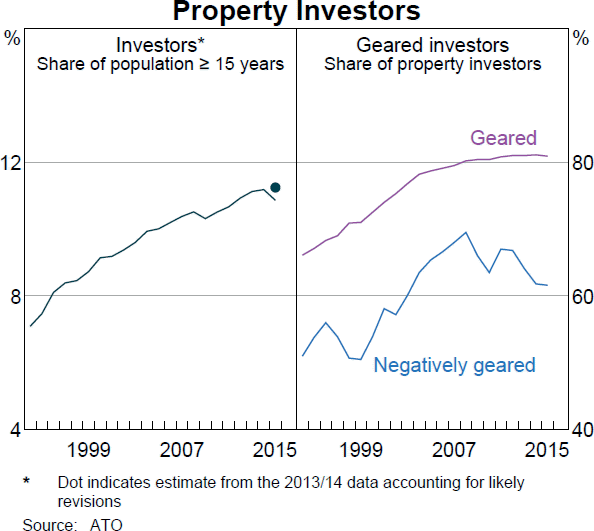
Number of properties
Around 70 per cent of investors own just one property. However, around half of investment properties are owned by investors with multiple properties; 20 per cent of investors own two properties and 10 per cent own three or more. The number of investors with multiple properties has grown relative to those with a single property, particularly between 2013/14 and 2014/15 (Graph B2). Indeed, the number of investors with five properties grew by 7½ per cent in that one year, compared with average growth of 4½ per cent over the previous nine years. The data do not provide information on the characteristics of investors with multiple properties and so they cannot shed light on the risks associated with these holders of multiple properties. However, given the strong growth in investor housing credit and riskier types of borrowing over this period, investors with multiple properties have likely contributed to higher risk.
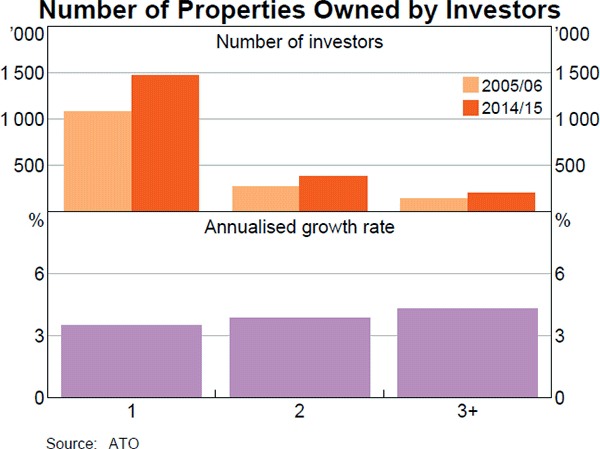
Income
Higher-income taxpayers are more likely to own investment properties than those on lower incomes. About 11 per cent of taxpayers earning under $50,000 have investment properties compared with around 30 per cent of taxpayers earning between $100,000 and $500,000. (The definition of income used here includes gross rent before deductions but excludes non-taxable sources of income such as drawdowns from superannuation.) However, while lower and middle-income households are less likely to own investment properties, they make up a larger share of property investors because there are more of these types of households (Graph B3). Lower-income households are just as likely as higher-income households to be negatively geared, with interest payments and other property expenses exceeding rental receipts. Indeed, the majority of investors with a mortgage are negatively geared.
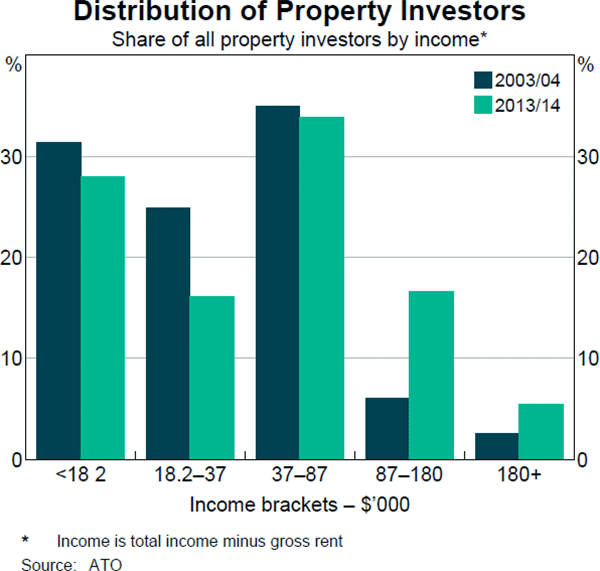
The absolute size of rental loss is largest for higher-income taxpayers (Graph B4).[5] Relative to total income, however, the rental loss is largest for the lowest income bracket and gets progressively smaller for higher income brackets. This suggests that lower-income taxpayers may be more vulnerable to increases in debt repayment obligations or reductions in income. They might also be more reliant on rental income to meet their repayments. About 35 per cent of individuals in the lowest income bracket are over the age of 60 and the majority of this income group did not have any salary income (though they may have superannuation or other non-taxable income not included in this classification). This suggests that this group could include people who are retired or temporarily out of the workforce. About 70 per cent of investors in this group also indicated that they have a partner; for these households, partner income might provide another source to service investor loans.
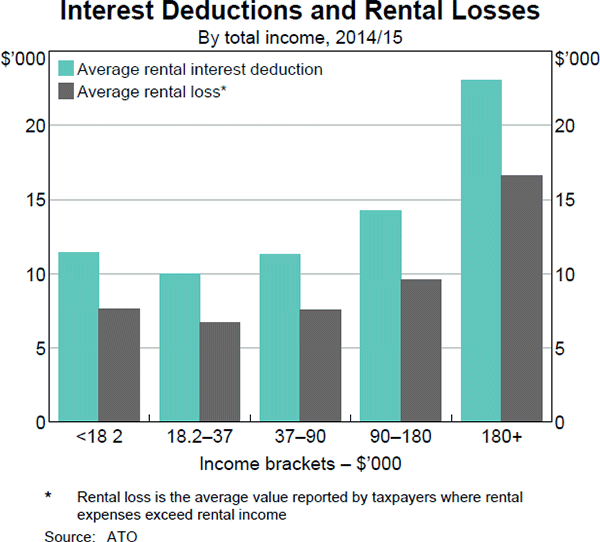
Profession
Professionals, for example teachers, lawyers and doctors, account for the largest share of property investors, reflecting their large share as taxpayers and their greater propensity to be investors; they account for 17 per cent of taxpayers and 22 per cent of investors (Table B1). Managers and professionals together account for over one-third of property investors, likely due to their relatively high median income. In contrast, lower-income occupations exhibit a lower propensity to invest in property; in general, they account for a smaller share of property investors than of their share as taxpayers. Even among some lower-income occupations, however, large proportions of investors are negatively geared. For example, 72 per cent of community and personal service worker investors and 67 per cent of sales worker investors are negatively geared compared with an average of 62 per cent across all occupations. These investors could be particularly vulnerable to an income shock affecting their ability to meet mortgage repayments.
| Occupation | Median salary income ($) | Share of all taxpayers (%) | Share of all investors (%) | Share of investors in occupation (%) | Share of occupation's investors that are negatively geared (%) |
|---|---|---|---|---|---|
| Managers | 65,784 | 10 | 15 | 23 | 71 |
| Professionals | 65,755 | 17 | 22 | 21 | 70 |
| Machinery operators & drivers | 55,542 | 5 | 3 | 11 | 74 |
| Technicians & trade workers | 54,256 | 9 | 8 | 14 | 73 |
| Clerical & administrative workers | 42,926 | 12 | 12 | 16 | 68 |
| Labourers | 32,396 | 8 | 3 | 7 | 66 |
| Community & personal service workers | 31,790 | 8 | 5 | 10 | 72 |
| Sales workers | 27,788 | 7 | 4 | 8 | 67 |
| Other(a) | 32,594 | 25 | 28 | 18 | 39 |
| Total(b) | 46,428 | 100 | 100 | 16 | 62 |
|
(a) About 80 per cent of the ‘other’ category is individuals
who did not report an occupation Source: ATO |
|||||
Age
There has been a marked increase in the age of property investors since the mid 2000s. Over the decade to 2014/15, the share of property investors who were aged 60 years and over almost doubled (Graph B5). This shift reflected both the increase in the share of the population aged over 60 and an increase in the extent of investment property ownership within this age group. Overall, around 20 per cent of taxpayers aged over 40 are property investors compared with less than 10 per cent of those under 40.
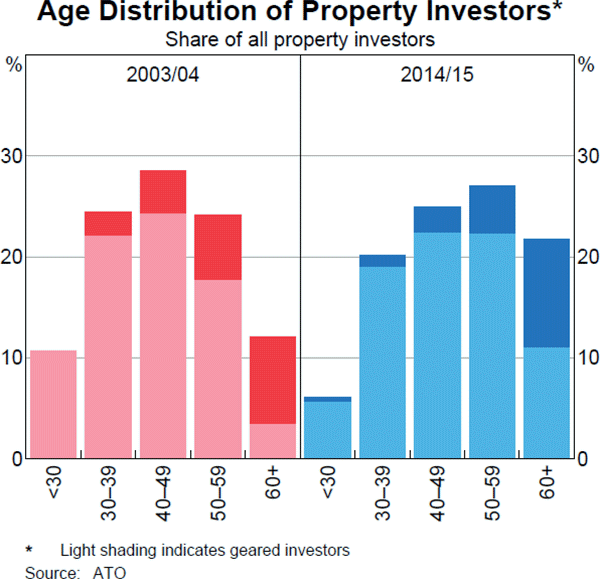
There has also been a significant increase in the share of geared investors aged over 60. While this seemingly could increase risks, there are some mitigating factors. Although this age group is more indebted, the average retirement age has increased over time, so older investors are more likely to be working, increasing their capacity to withstand shortfalls in rental income or higher interest rates. In 2004, just under 50 per cent of indebted investors over the age of 60 received salary income, but this had increased to 60 per cent in 2015. Older investors may also have greater accumulated wealth that could enable them to withstand lower rental income or higher mortgage interest. They might also have lower personal expenses.
Overall, however, borrowing has remained far more prevalent among younger investors, with almost all investors below the age of 40 years being indebted. While these investors generally have stable wage and salary income, they also have relatively high personal expenses that can reduce their ability to cushion changes in rental income and interest rates.
State
In most states, the share of the Australian population who own an investment property is similar to the overall share of investment properties located in that state. Queensland is a notable exception – around 25 per cent of all rental properties are in Queensland but less than 20 per cent of investors are from Queensland. This suggests a sizeable share of investment properties in Queensland are owned by investors with multiple properties or people not residing in the state, who are possibly less informed about the local property and rental market. This could increase the likelihood of many investors selling in a sharp downturn. Information from liaison suggests there was strong investor demand due to dwelling price and yield differentials with other states and the active role of property marketers, particularly in areas of Queensland exposed to the resources boom.
Footnotes
Two caveats of these data are that they are only available with a lag (currently covering up to the 2014/15 tax year) and they cannot separate commercial from residential property, although most property investments are residential. [1]
For further details, see RBA (2017) ‘Box C: Characteristics of Highly Indebted Households’, Financial Stability Review, April, pp 29–32. [2]
For further details, see RBA (2017) ‘Box B: Interest-only Mortgage Lending’, Financial Stability Review, April, pp 26–28. [3]
The number of property investors is the number of tax return lodgers reporting net rental profit or loss. Geared investors are the number of investors making interest deductions and negatively geared investors are those reporting net rental losses. [4]
Interest payments make up around half of rental property expenses. There are many other smaller expenses that contribute to investors making a net loss such as council rates and capital works deductions. [5]